

Author: Peng Zhao (Founder of Zhici Fang, Co-founder and Partner of Yunhe Capital)
Original from IoT Think Tank
Despite the wave of digital transformation sweeping the industrial sector for over a decade, most factory systems remain at the stage of “automation rather than intelligence.” Although sensors, PLCs, MES, cloud platforms, and other components are all available, the systems are fragmented, making data collection possible but difficult to interpret. Algorithms can run but cannot adapt to changes, and achieving a true closed-loop intelligence of “perception-cognition-decision” remains elusive. Why does AI receive praise in industrial scenarios but fail to gain traction? Why do AI models continue to grow stronger while their applications remain stagnant? Where exactly is the breakthrough point for industrial intelligence? We may be standing at a new historical turning point. The combination of AI agents and edge computing is emerging as a new path to solve these problems. It is not just a technical combination but a reconstruction of the industrial development model:
-
Edge computing brings computing power to the site, supporting millisecond-level data processing and instant feedback;
-
AI agents empower edge nodes with the autonomous capability of “perception-cognition-decision”;
-
Together, they drive industrial systems from “passive response” to “active evolution,” transitioning from “centralized automation” to a “distributed agent network.”
In this context, the IoT Think Tank had the privilege of engaging in an in-depth discussion about the “Era of Industrial Intelligence” with Liu Kezhen, Chairman of Advantech, and Kang Ning, Director of WISE-PaaS / AI Agent R&D. This article will explore how edge computing and AI agents can build a new foundation for industrial intelligence from three dimensions: technology, strategy, and ecology, and predict the future of the industry driven by the dual engines of “vertical models + edge intelligence.”
AI Agents Take the Stage: The New Engine of Industrial Intelligence’s “Perception-Cognition-Execution”
If edge computing is the infrastructure upgrade for industrial intelligence, then the introduction of AI agents signifies a shift in industrial systems from a “process-driven” to an “intelligence-driven” model. 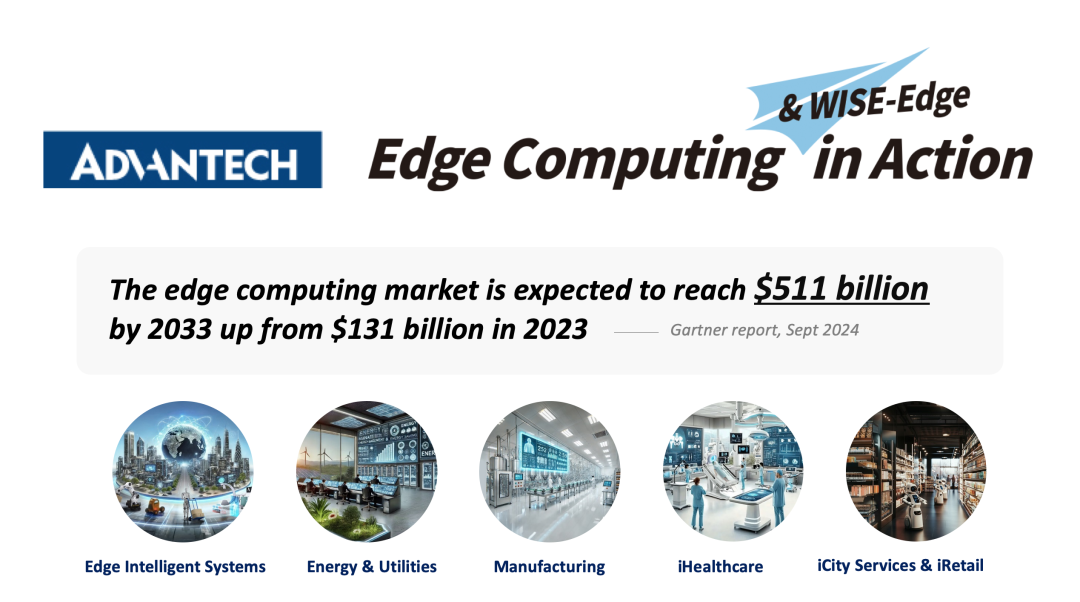 There is no doubt that more and more enterprise applications are beginning to run at the edge. According to Gartner’s predictions, by 2027, 50% of critical enterprise applications will run at the edge. Enterprises are continuously investing in edge computing, with global edge computing spending expected to grow at a double-digit compound annual growth rate (CAGR) from 2024 to 2033. Coupled with the continuous evolution of AI, edge intelligence is also showing strong development momentum. Gartner further predicts that by 2026, 50% of global edge deployments will include AI. Liu Kezhen, Chairman of Advantech, keenly observed that the evolution of automation to intelligence in industrial scenarios has reached a significant turning point. Although the adoption of AI has not been long, its trend is very strong. As the integration of AI agents and specialized AI models becomes more refined, comprehensive AI agents in industrial scenarios are beginning to lead the intelligent transformation. In the past, without cloud-edge collaborative solutions, each factory’s industrial control ecosystem was customized by automation teams based on in-scenario needs, forming a closed system. This system relied on preset rules and static logic, making it difficult to cope with complex and dynamic production environments. With the widespread application of cloud-edge collaborative computing, the originally closed industrial systems are beginning to be liberated. In the era of AI agents, production resources within the scenario will be further integrated into specific small models (SLM), achieving intelligent communication and sharing through comprehensive industry knowledge in the cloud and at the edge. Liu Kezhen stated, “Industrial intelligence will connect everything within the scenario, leading to explosive growth in the efficiency and intelligence of the entire industry.” Intelligent entities with environmental perception, autonomous decision-making, and execution capabilities achieve a leap from “passive execution” to “active evolution” through the closed loop of “perception-decision-execution.” This capability makes AI agents the ultimate carrier of industrial AI: they can be embedded in physical devices to achieve “edge intelligence” and can form “collective wisdom” through cloud training and iteration, driving industrial systems from “customized but closed local optimization” to “open and customized global intelligence.” The so-called AI agent is not a single functional module but an intelligent entity capable of perceiving the environment, understanding tasks, making autonomous decisions, and executing collaboratively. They are embedded at the device or edge node, capable of independently completing the closed-loop work from data collection, analysis, judgment to action without relying on the cloud, becoming the true “executors” and “thinkers” of edge intelligence. The three core capabilities of industrial AI agents include: 1. Perception capabilities
There is no doubt that more and more enterprise applications are beginning to run at the edge. According to Gartner’s predictions, by 2027, 50% of critical enterprise applications will run at the edge. Enterprises are continuously investing in edge computing, with global edge computing spending expected to grow at a double-digit compound annual growth rate (CAGR) from 2024 to 2033. Coupled with the continuous evolution of AI, edge intelligence is also showing strong development momentum. Gartner further predicts that by 2026, 50% of global edge deployments will include AI. Liu Kezhen, Chairman of Advantech, keenly observed that the evolution of automation to intelligence in industrial scenarios has reached a significant turning point. Although the adoption of AI has not been long, its trend is very strong. As the integration of AI agents and specialized AI models becomes more refined, comprehensive AI agents in industrial scenarios are beginning to lead the intelligent transformation. In the past, without cloud-edge collaborative solutions, each factory’s industrial control ecosystem was customized by automation teams based on in-scenario needs, forming a closed system. This system relied on preset rules and static logic, making it difficult to cope with complex and dynamic production environments. With the widespread application of cloud-edge collaborative computing, the originally closed industrial systems are beginning to be liberated. In the era of AI agents, production resources within the scenario will be further integrated into specific small models (SLM), achieving intelligent communication and sharing through comprehensive industry knowledge in the cloud and at the edge. Liu Kezhen stated, “Industrial intelligence will connect everything within the scenario, leading to explosive growth in the efficiency and intelligence of the entire industry.” Intelligent entities with environmental perception, autonomous decision-making, and execution capabilities achieve a leap from “passive execution” to “active evolution” through the closed loop of “perception-decision-execution.” This capability makes AI agents the ultimate carrier of industrial AI: they can be embedded in physical devices to achieve “edge intelligence” and can form “collective wisdom” through cloud training and iteration, driving industrial systems from “customized but closed local optimization” to “open and customized global intelligence.” The so-called AI agent is not a single functional module but an intelligent entity capable of perceiving the environment, understanding tasks, making autonomous decisions, and executing collaboratively. They are embedded at the device or edge node, capable of independently completing the closed-loop work from data collection, analysis, judgment to action without relying on the cloud, becoming the true “executors” and “thinkers” of edge intelligence. The three core capabilities of industrial AI agents include: 1. Perception capabilities
-
Multimodal sensor fusion (vision, sound, vibration, temperature and humidity, etc.)
-
Real-time data collection and edge-side preprocessing
-
State recognition and environmental understanding
2. Cognitive capabilities
-
Task understanding and reasoning analysis supported by embedded AI small models
-
Intelligent decision-making mechanisms in collaboration with industry knowledge graphs
-
Self-learning and model optimization
3. Decision-making and execution capabilities
-
Issuing control commands linked to on-site devices
-
Coordinated scheduling among multiple agents
-
Feedback and self-correction after task completion
This capability structure transforms AI agents from passive algorithm tools into intelligent work nodes with “context understanding + collaborative execution,” promoting the evolution of industrial systems from “instruction-based execution” to “goal-oriented collaboration.” It should be noted that the rise of AI agents does not disrupt the traditional automation upgrade path but reconstructs the underlying logic of industrial intelligence through more comprehensive data, more refined models, and more powerful edge computing, using the autonomous cognition of agents to drive the enhancement of scene intelligence. The introduction of industrial AI agents is not a replacement for traditional automation but a leap in system architecture and intelligent logic. Kang Ning, R&D Director of Advantech, also mentioned that this leap in industrial intelligence requires agents to build the intelligent hub of IoT and model integration within industrial scenarios, completing the end-to-end closed loop of data from perception, aggregation to autonomous decision-making and even execution, ultimately helping enterprises build their own “think tanks.” 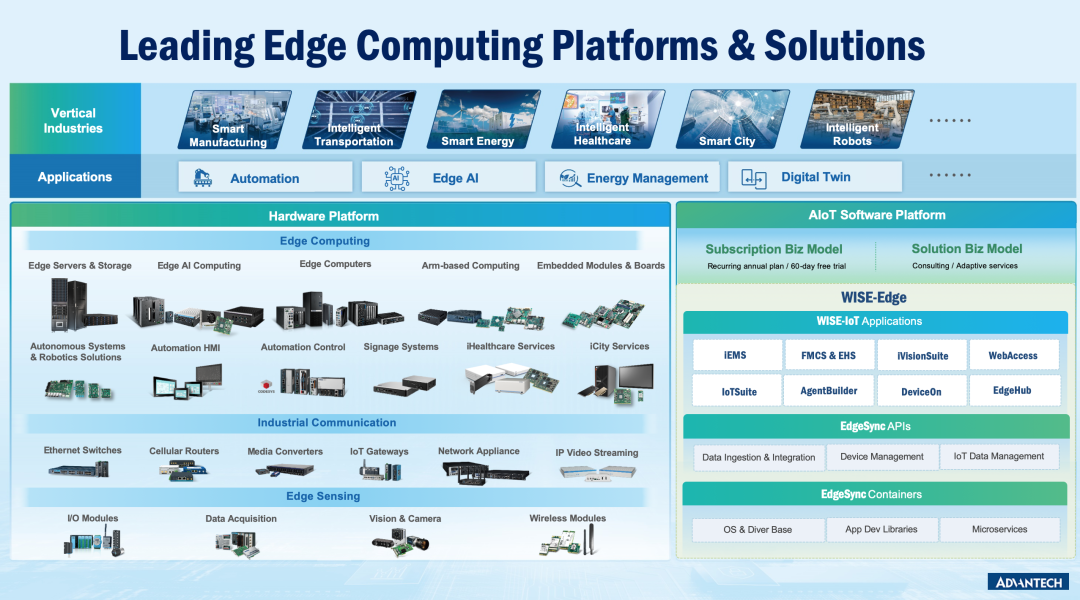 It is expected that there will be many demands arising in the entire industry for edge intelligence transformation. It is in this opportunity that Advantech began its strategic transformation from an “industrial computer leader” to an “Edge AI leader,” shifting from providing industry hardware platforms and software tools to developing AI Agent on Edge, which thoroughly integrates edge computing hardware and intelligent software to solve many technical bottlenecks in the implementation of industrial AI, promoting the comprehensive intelligence of industrial applications based on the deep coupling of OT and IT.
It is expected that there will be many demands arising in the entire industry for edge intelligence transformation. It is in this opportunity that Advantech began its strategic transformation from an “industrial computer leader” to an “Edge AI leader,” shifting from providing industry hardware platforms and software tools to developing AI Agent on Edge, which thoroughly integrates edge computing hardware and intelligent software to solve many technical bottlenecks in the implementation of industrial AI, promoting the comprehensive intelligence of industrial applications based on the deep coupling of OT and IT.
From Underlying Technology to Ecological Collaboration, Building Core Capabilities of Industrial AI Agents
Whether it is industrial AI or specifically industrial intelligence agents, their core technology system revolves around data-driven decision-making, real-time response, and autonomous collaboration, which can be broken down into several core modules:
-
Local real-time data processing brought by edge computing hardware: Edge computing hardware achieves millisecond-level response by bringing computing power to the device side or near-field nodes, meeting the stringent requirements of industrial scenarios for low latency;
-
Refined AI models based on industrial scenarios: Customized scene AI models optimized through techniques such as model pruning and quantization to adapt to resource-constrained edge computing hardware;
-
AI software integration platform and application suite adapted to computing power hardware: A modular AI software integration platform that separates different functions and components for easier development, maintenance, and expansion. At the same time, container software is used to develop AI application suites, improving resource utilization and deployment efficiency.
During the discussion, we also learned that Advantech is laying out core technologies around industrial intelligence agents, such as developing Edge AI acceleration modules, Edge AI industrial application systems, Edge AI large language model training systems, and Edge AI servers, as well as providing integrated AI software platform tools like Edge AI SDK to assist industrial customers in evaluating and validating AI platform performance and application development, while collaborating with mainstream chip manufacturers to develop high-performance edge AI computing platforms. 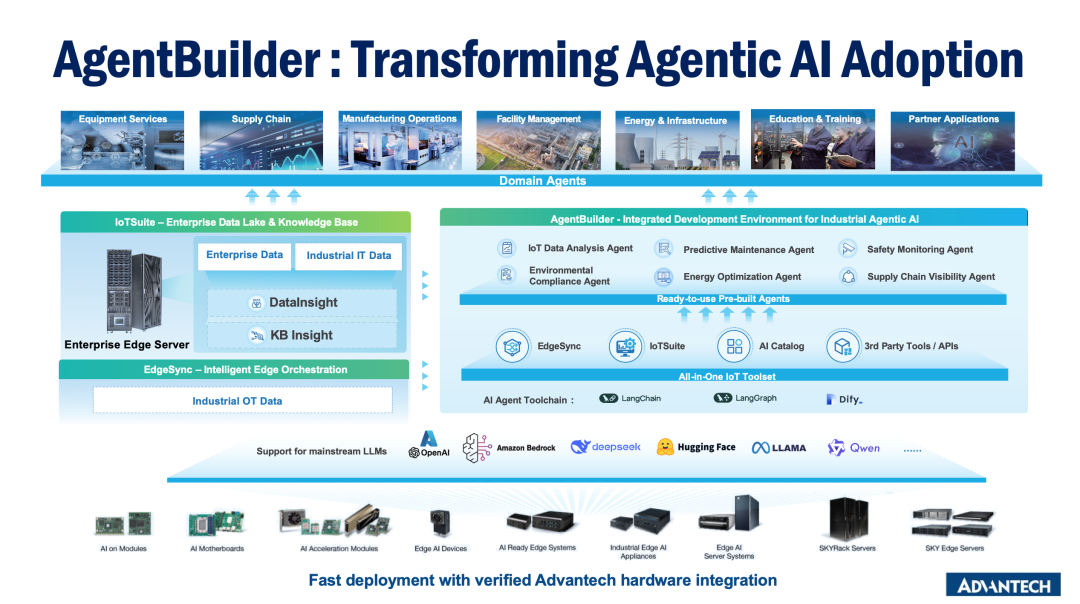 The fragmentation of industrial data and low utilization, the stringent requirements for decision certainty and interpretability in industrial scenarios, and the collaboration of AI agents are also challenges that industrial intelligence agents will face in their popularization. Advantech is laying out related technology stacks, providing products such as edge-side multimodal data collection and communication connection products, industrial scenario AI algorithm expert libraries, and the Agent Builder intelligent agent platform that connects data streams, etc. The “penetration” of hardware and application software has significant implications for industrial transformation. These products surrounding the core technology system of industrial intelligence agents provide a bridge for industrial customers to quickly integrate AI into industrial applications. Of course, in addition to the underlying software and hardware, the entire upstream and downstream ecological collaboration and industry co-creation are also essential to promote industrial intelligence development. In a deep conversation with Liu Kezhen, Chairman of Advantech, a core judgment gradually became clear: industrial intelligence agents are not a technological innovation but a systemic transformation. The core of this transformation lies not in whether “AI is strong enough” but in whether enterprises are ready to embrace a new industrial future dominated by “intelligent collaboration.”
The fragmentation of industrial data and low utilization, the stringent requirements for decision certainty and interpretability in industrial scenarios, and the collaboration of AI agents are also challenges that industrial intelligence agents will face in their popularization. Advantech is laying out related technology stacks, providing products such as edge-side multimodal data collection and communication connection products, industrial scenario AI algorithm expert libraries, and the Agent Builder intelligent agent platform that connects data streams, etc. The “penetration” of hardware and application software has significant implications for industrial transformation. These products surrounding the core technology system of industrial intelligence agents provide a bridge for industrial customers to quickly integrate AI into industrial applications. Of course, in addition to the underlying software and hardware, the entire upstream and downstream ecological collaboration and industry co-creation are also essential to promote industrial intelligence development. In a deep conversation with Liu Kezhen, Chairman of Advantech, a core judgment gradually became clear: industrial intelligence agents are not a technological innovation but a systemic transformation. The core of this transformation lies not in whether “AI is strong enough” but in whether enterprises are ready to embrace a new industrial future dominated by “intelligent collaboration.” 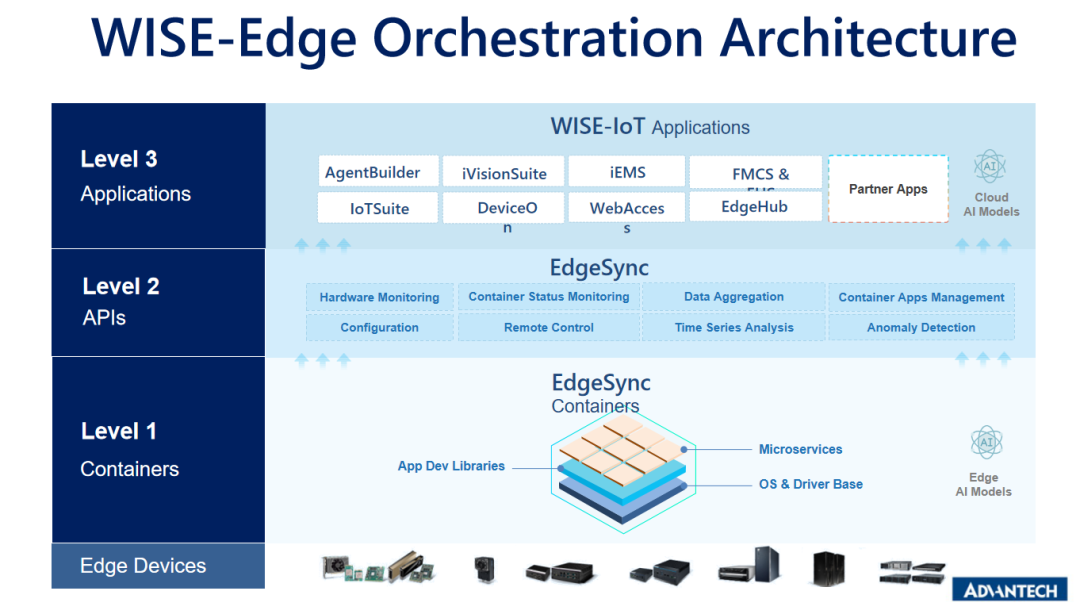 Liu Kezhen particularly emphasized during the discussion that Advantech is accelerating cooperation with upstream and downstream partners in the industry chain through the WISE-Edge strategy of linking edge-end software and hardware integration, building an industrial intelligence agent ecosystem that brings together AI chip manufacturers, multimodal sensor suppliers, AI software technology companies, industry system integrators, and channel distributors focused on edge intelligence, forming a joint force to build a prosperous ecosystem covering “end-edge-cloud.” Consequently, Advantech is transitioning to the role of “AIoT ecosystem promoter”:
Liu Kezhen particularly emphasized during the discussion that Advantech is accelerating cooperation with upstream and downstream partners in the industry chain through the WISE-Edge strategy of linking edge-end software and hardware integration, building an industrial intelligence agent ecosystem that brings together AI chip manufacturers, multimodal sensor suppliers, AI software technology companies, industry system integrators, and channel distributors focused on edge intelligence, forming a joint force to build a prosperous ecosystem covering “end-edge-cloud.” Consequently, Advantech is transitioning to the role of “AIoT ecosystem promoter”:
-
Collaborating with AI chip manufacturers to build an edge-end computing power ecosystem;
-
Joining forces with system integrators to create industry solutions;
-
Connecting channels and customers to build an edge intelligence scenario library.
The goal of this strategic transformation is to create an industrial intelligence agent ecosystem covering “end-edge-cloud,” achieving a leap from “hardware and software supply” to “empowerment platform.” 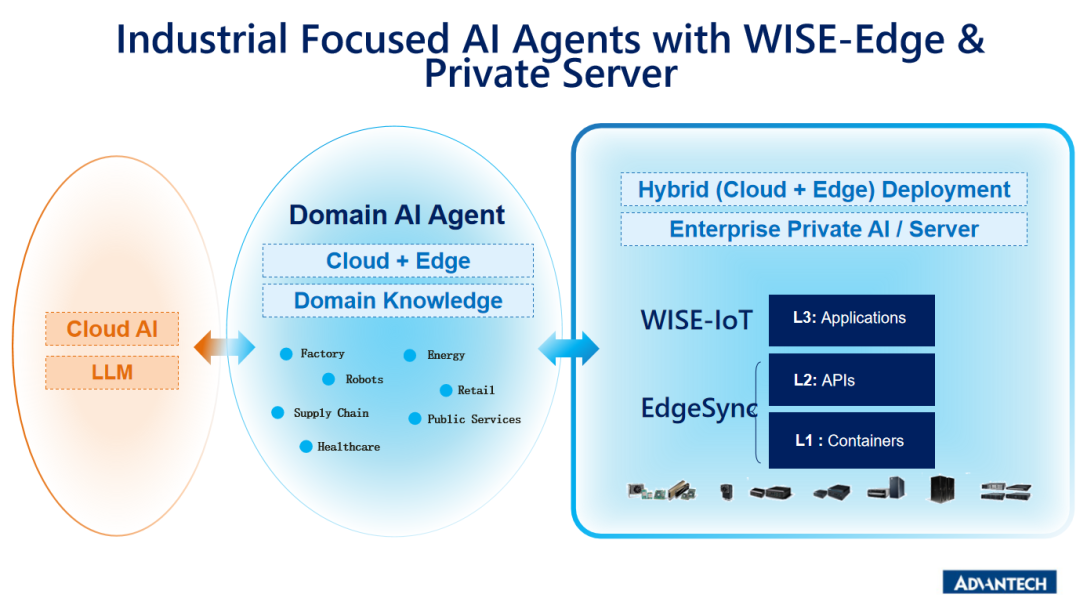 This series of profound strategic judgments not only points out the transformation path for Advantech from “industrial computer to industrial intelligence agent platform” but also provides a reference system-level architecture blueprint for the entire industrial AI ecosystem. The implementation of AI applications cannot rely solely on one enterprise; it should be a joint effort of the entire upstream and downstream industry chain to create a virtuous ecosystem for common development, allowing the industry to move towards the direction of edge AI and industrial intelligence.
This series of profound strategic judgments not only points out the transformation path for Advantech from “industrial computer to industrial intelligence agent platform” but also provides a reference system-level architecture blueprint for the entire industrial AI ecosystem. The implementation of AI applications cannot rely solely on one enterprise; it should be a joint effort of the entire upstream and downstream industry chain to create a virtuous ecosystem for common development, allowing the industry to move towards the direction of edge AI and industrial intelligence.
Vertical Models Will Inevitably Rise, and the Era of Industrial Intelligence Agents Will Eventually Arrive
Both the IoT Think Tank and Advantech hold an optimistic view on the rise of edge intelligence or industrial intelligence agents, believing that this industry transformation is certain to happen. Although the capabilities of industrial AI models have not yet evolved to a very complete level, and there are still many obstacles to achieving true industrial intelligence agents, in today’s competitive business environment, AI capabilities have become a core competitive advantage for enterprises. The lack of AI capabilities will cause enterprises to gradually fall behind in the wave of intelligence. As the multi-level computing power of industrial edge gradually improves and models evolve from quantitative to qualitative changes, the era of industrial intelligence agents is approaching. During the discussion, Liu Kezhen particularly mentioned “vertical AI models” and believes that the capabilities of large language models and general models are becoming stronger, and market demand is nearing saturation, with many now moving towards open-source and free business models. The emergence of industry vertical models provides a profitable business opportunity. “Vertical models have a strong mechanism for closing the business model loop because models tailored to specific industries are precious and possess exclusivity. In the future, vertical models may achieve breakthroughs in user binding and charging value.” At the same time, Liu Kezhen believes that vertical models in vertical fields should occur first, further driving edge intelligence. In “Edge Intelligence + Vertical Models: The “Dual Engines” of AIoT 2.0,” I previously mentioned that “the rise of vertical models is inevitable” due to the lack of data from the physical world, which leads to the inherent shortcomings of general models in the physical world, making it impossible to perfectly fit the complex and changing industry demands. To enable AI models to better understand industry knowledge and solve specific domain problems, customized models for vertical industries become the inevitable path for AI to transition from “general intelligence” to “scene intelligence.” For AIoT scenarios, edge intelligence and vertical models are the dual engines; edge intelligence serves as the infrastructure, and on the maturity of infrastructure transformation, various industries develop specific vertical models, meaning the maturity of vertical models lags behind that of edge intelligence hardware facilities. Whether edge intelligence hardware comes first or vertical models come first, there is a consensus on the inevitable rise of vertical models, and industrial intelligence agents based on vertical model capabilities will ultimately bring about a thorough intelligent transformation in industrial scenarios.
Final Thoughts
From large models to small models to vertical models, from edge computing to edge intelligence, the industry still needs some time to reach a consensus on these cutting-edge development directions and patiently wait for industry maturity. The birth of industrial intelligence agents is not only a continuation of industrial automation but also a reconstruction of the manufacturing operating system. It will drive the industry from “tool intelligence” to “system intelligence,” from “data-driven” to “knowledge autonomy.” With continuous technological advancements and the expansion of application scenarios, industrial intelligence agents combining edge intelligence and vertical models will unleash unprecedented energy, greatly enhancing productivity and resource allocation efficiency, and fundamentally reshaping production modes, promoting high-quality development of intelligent industry.